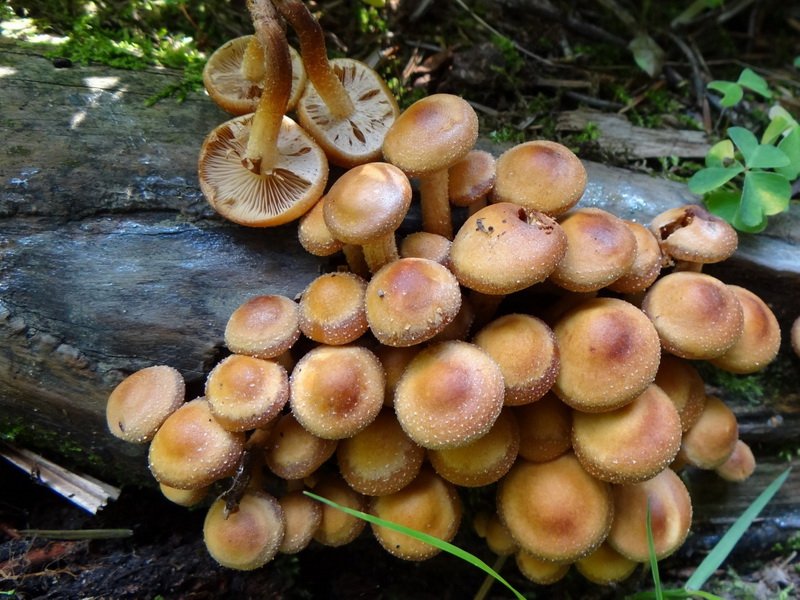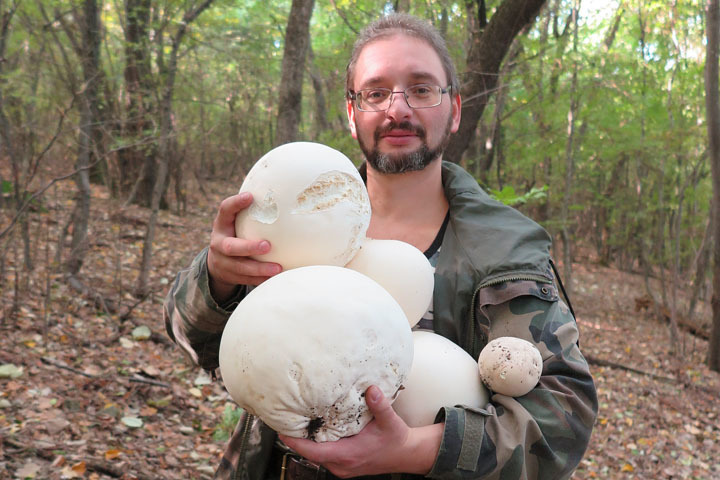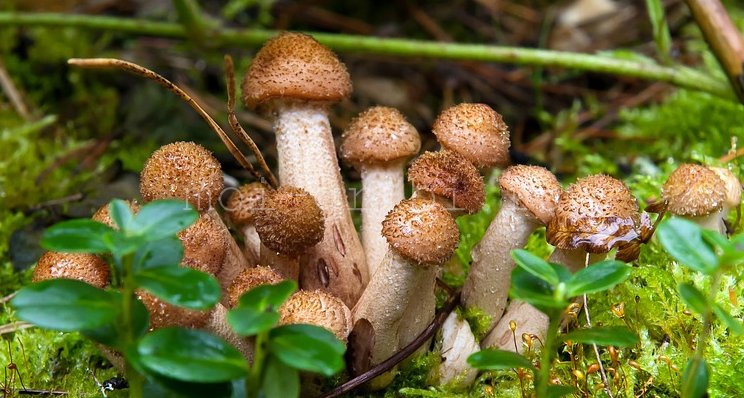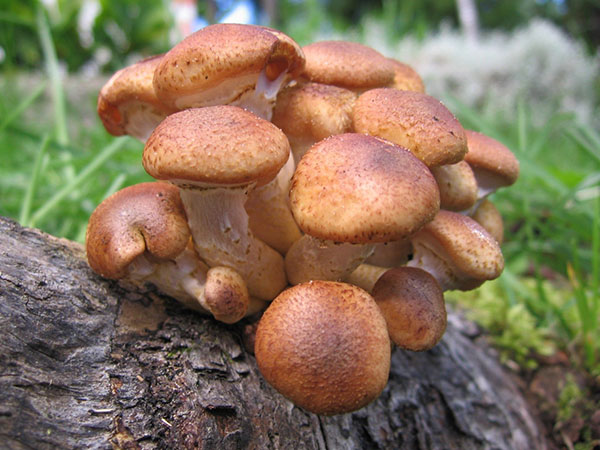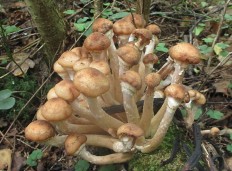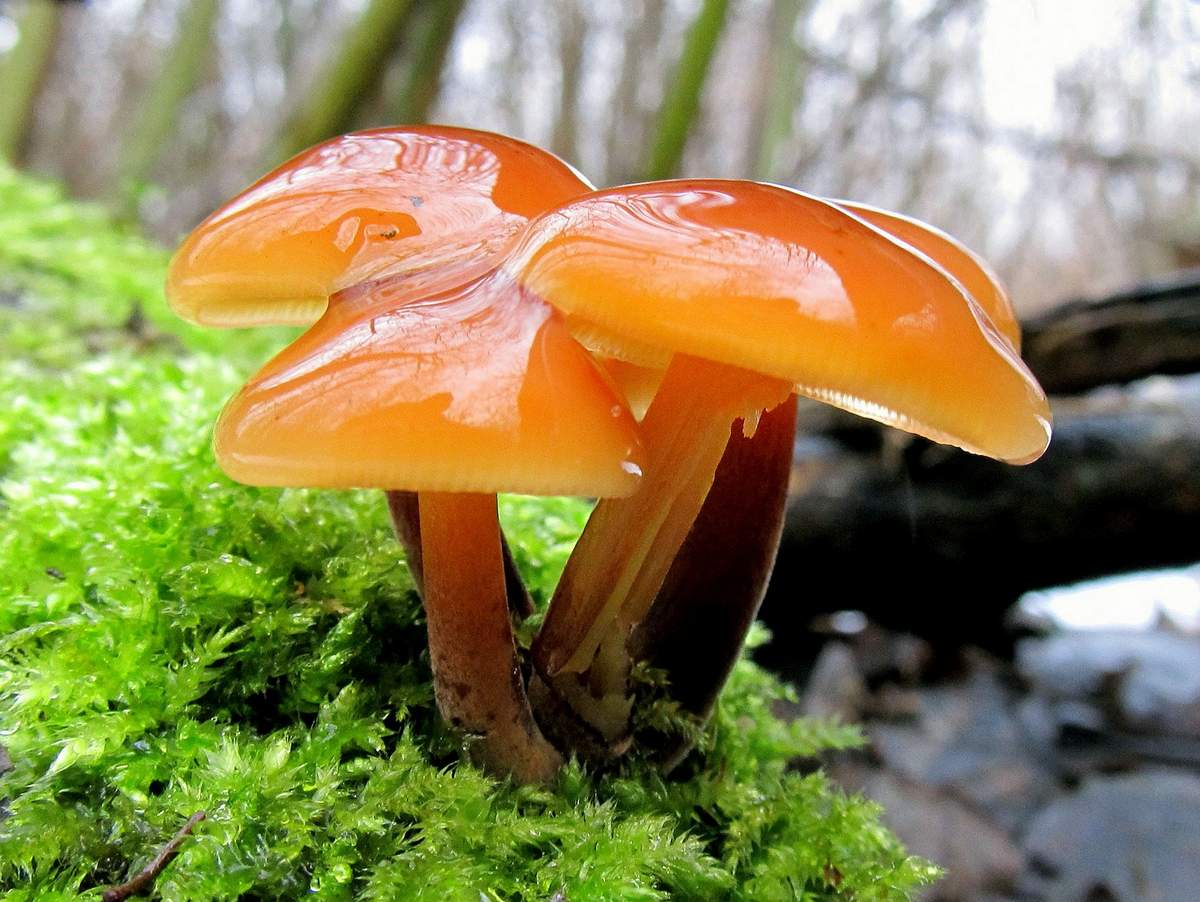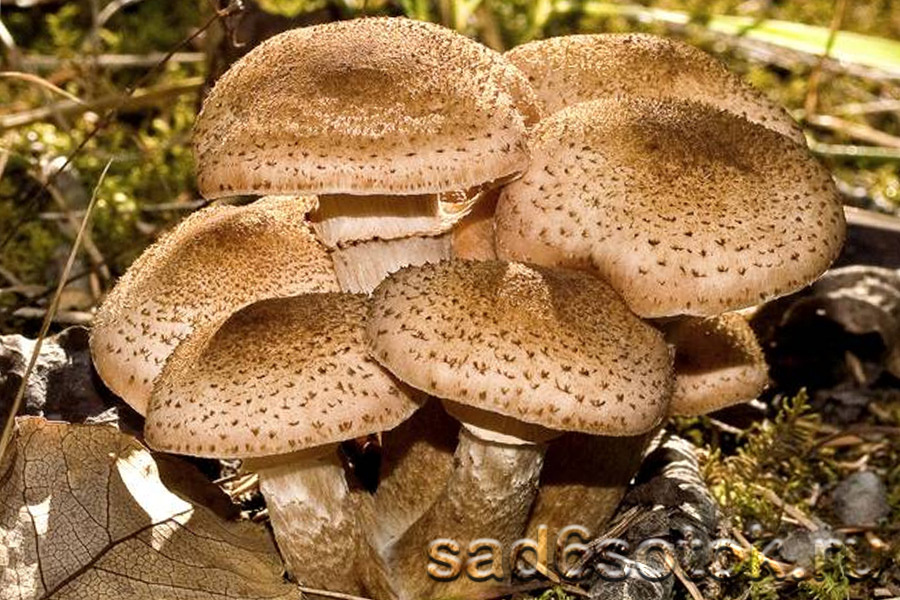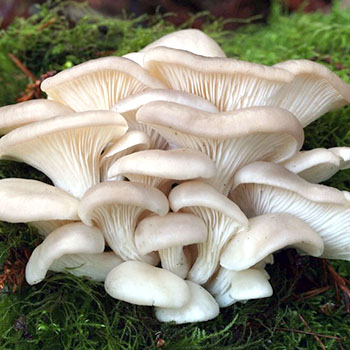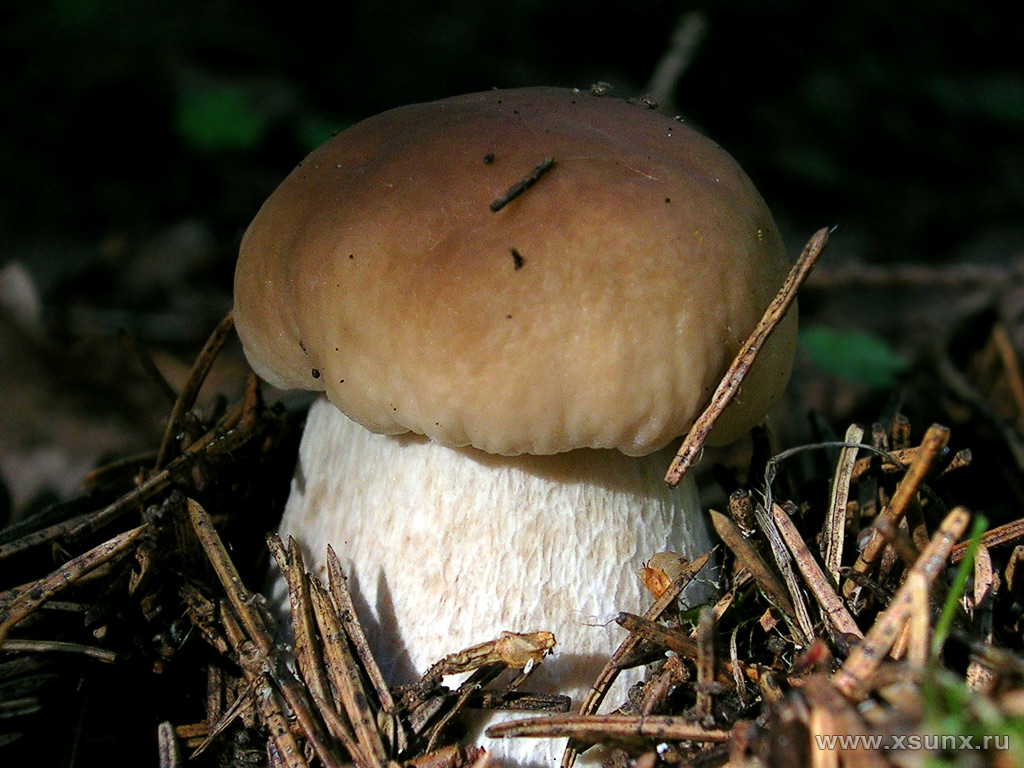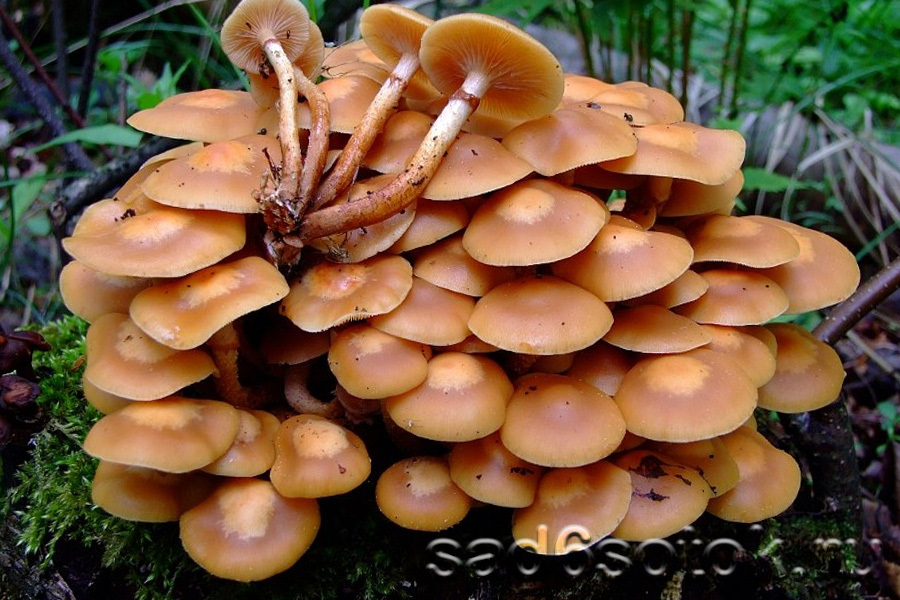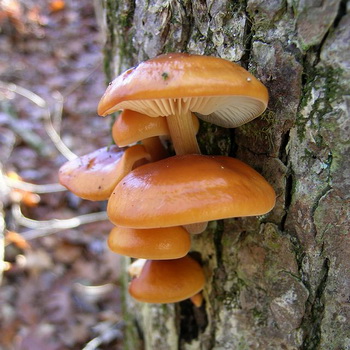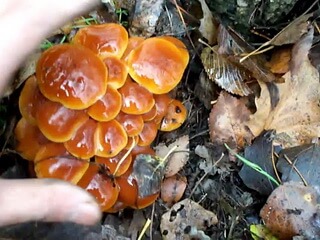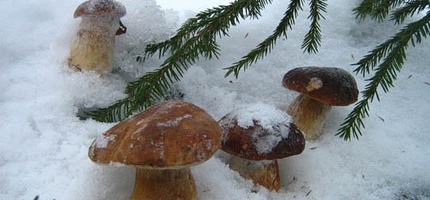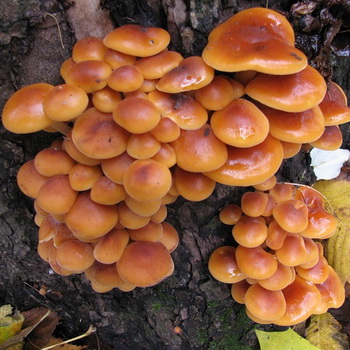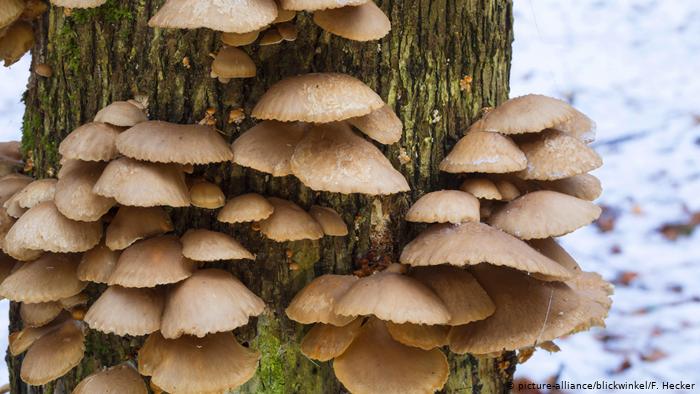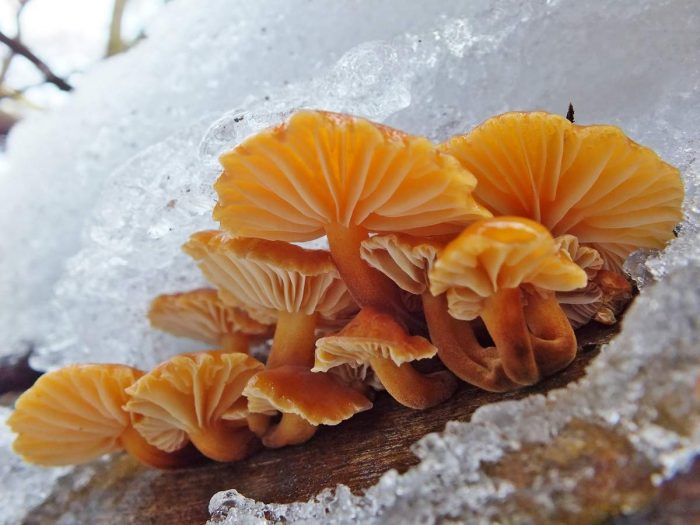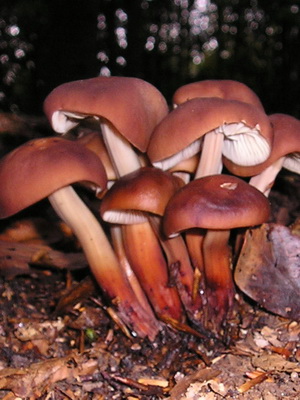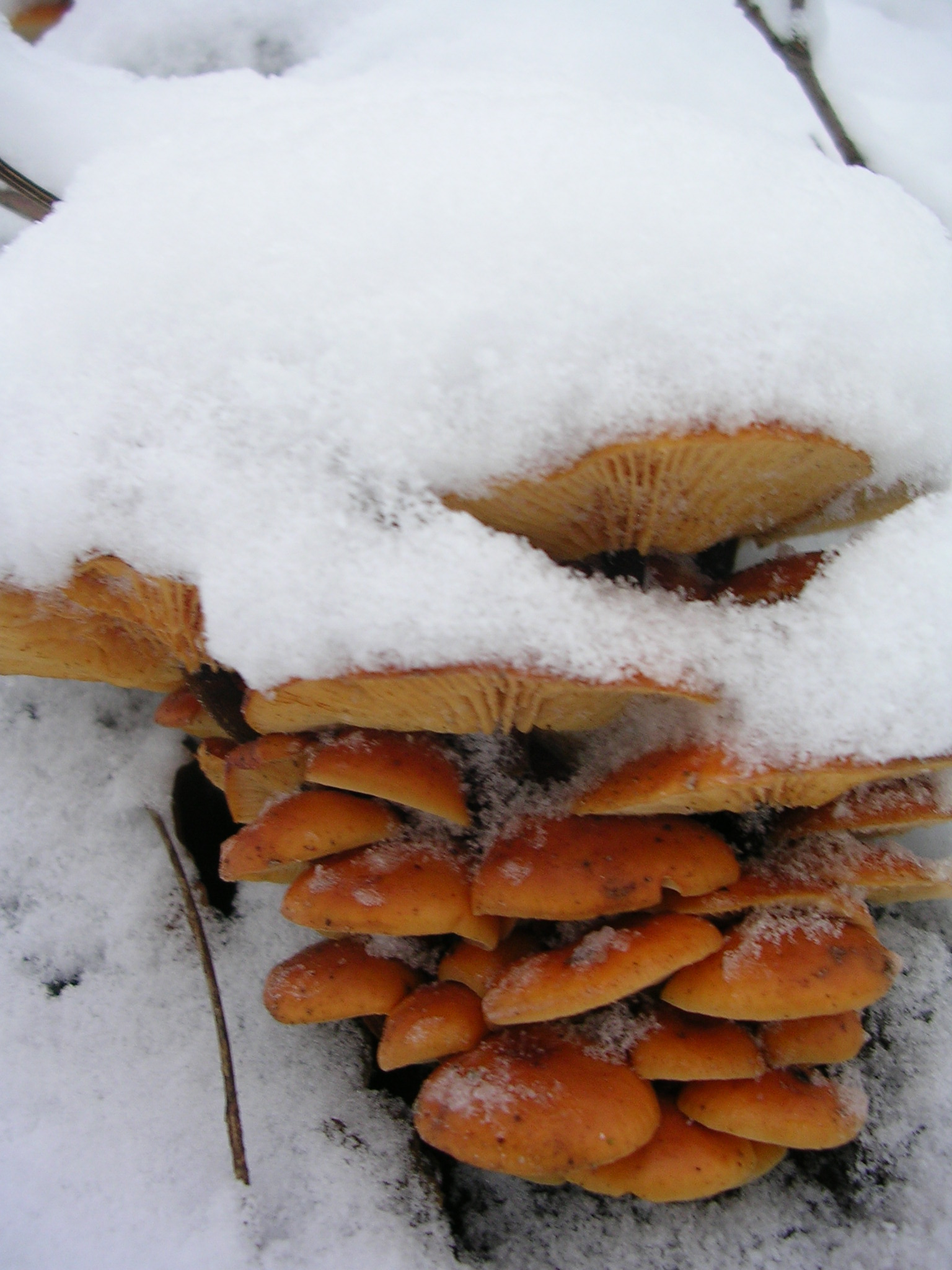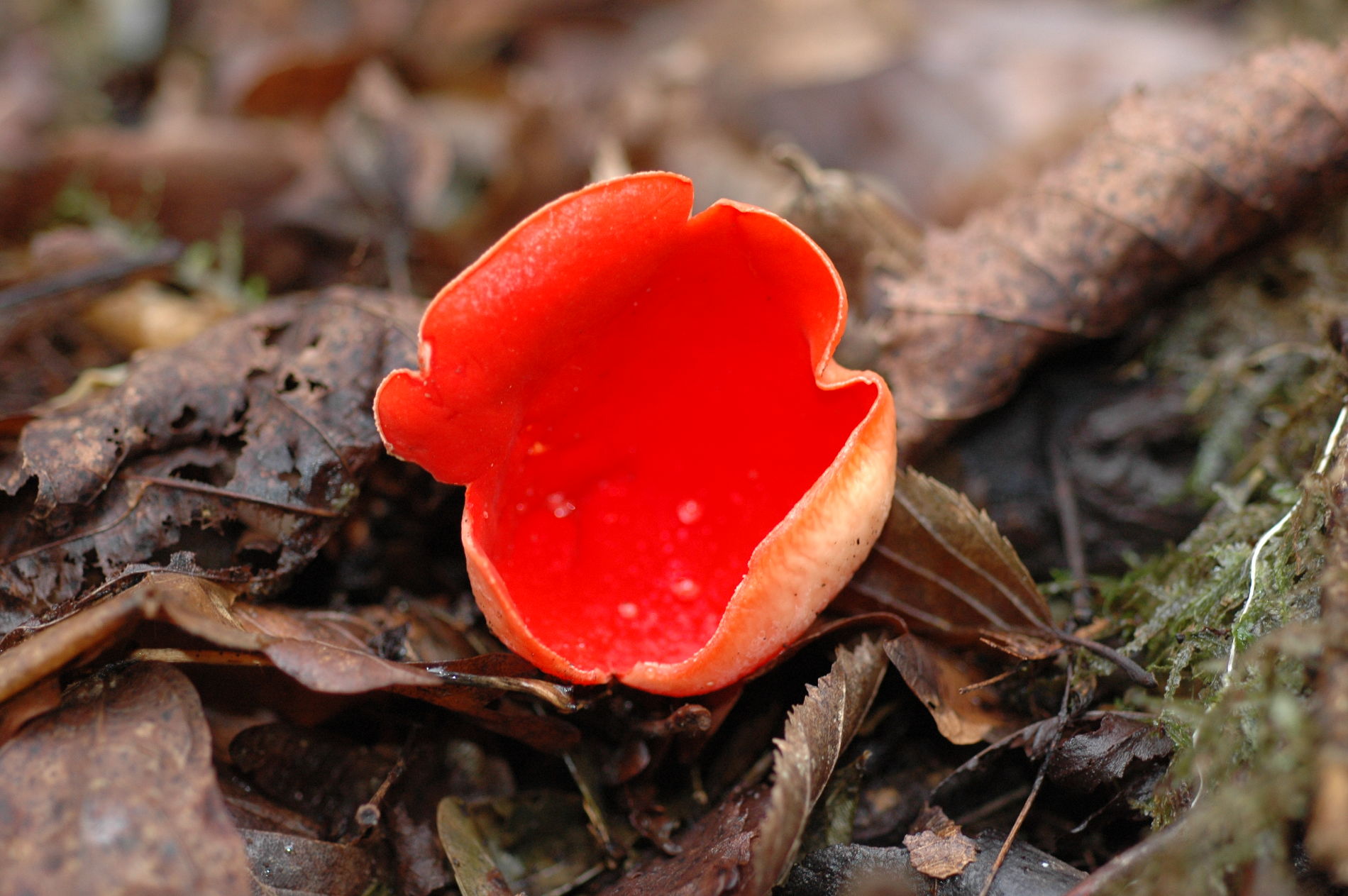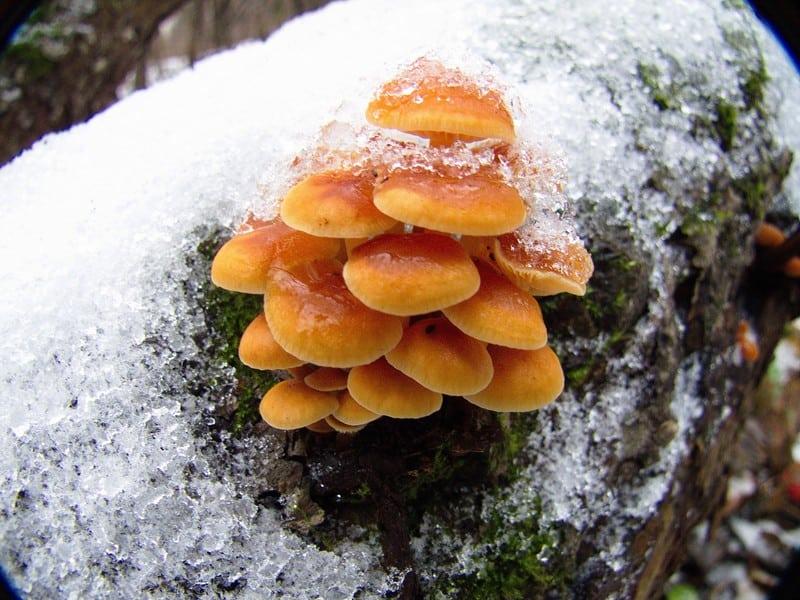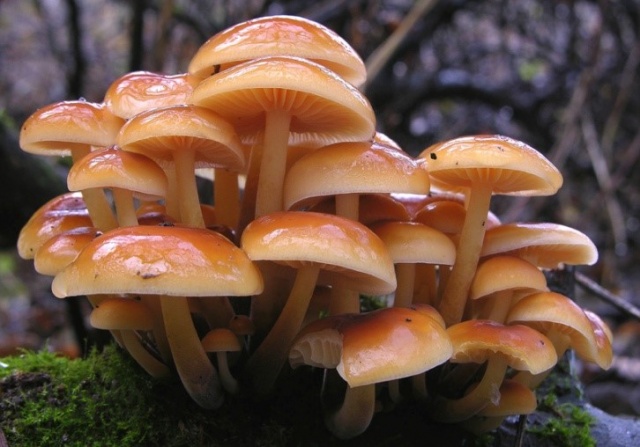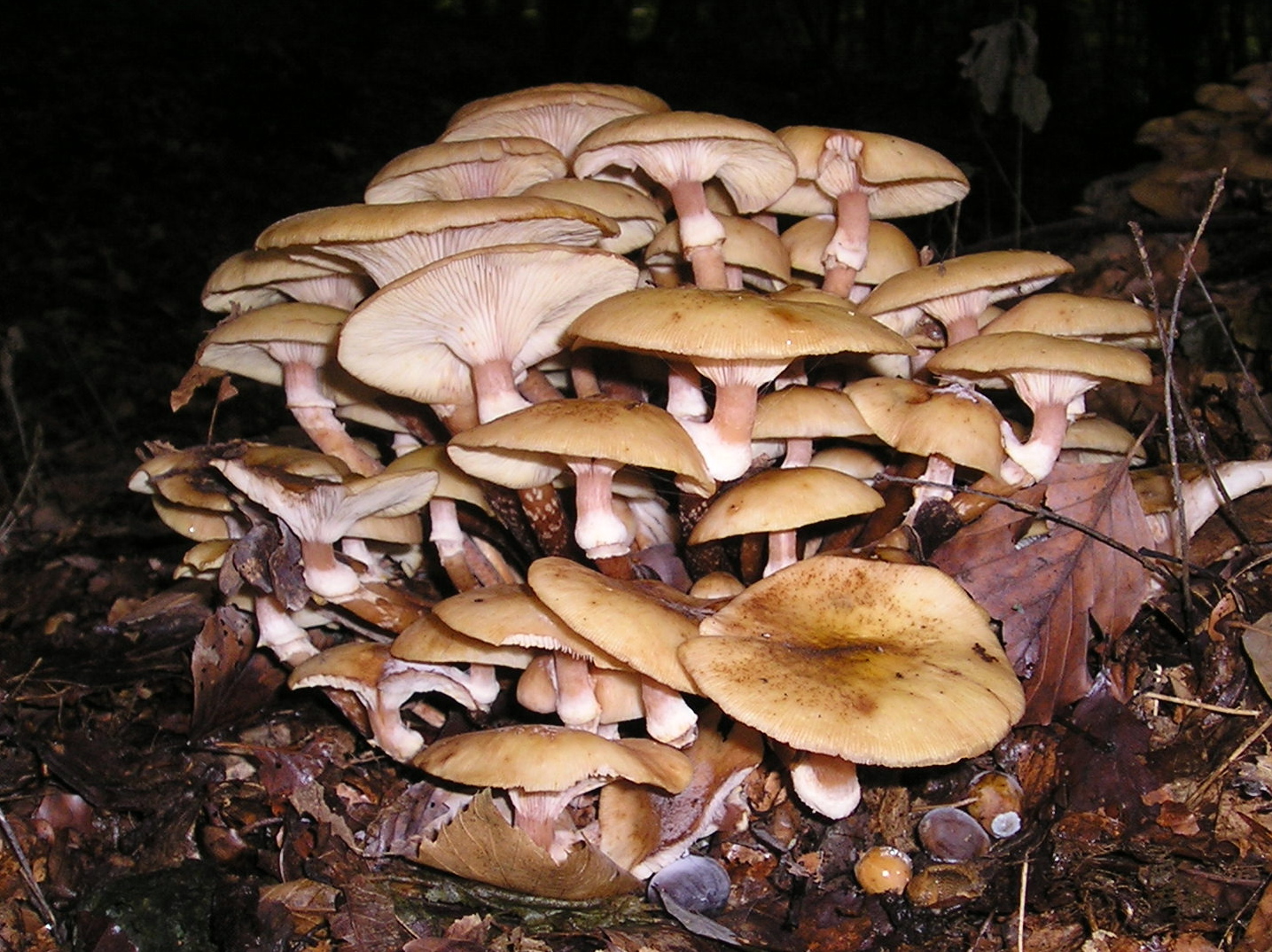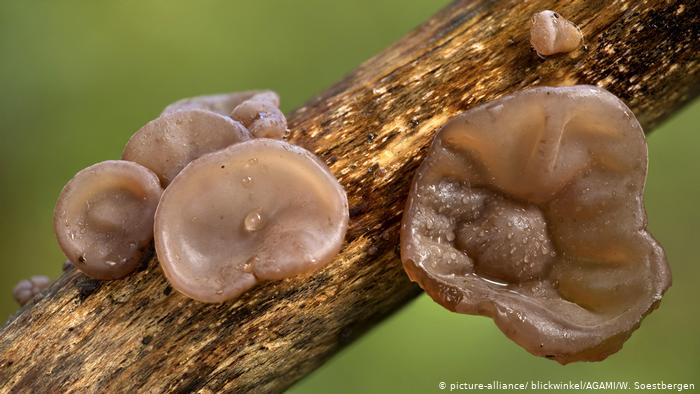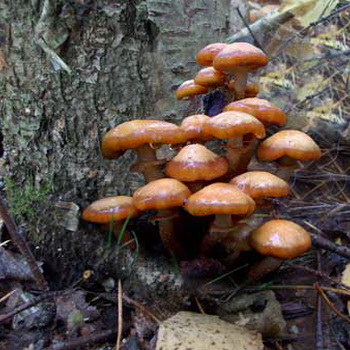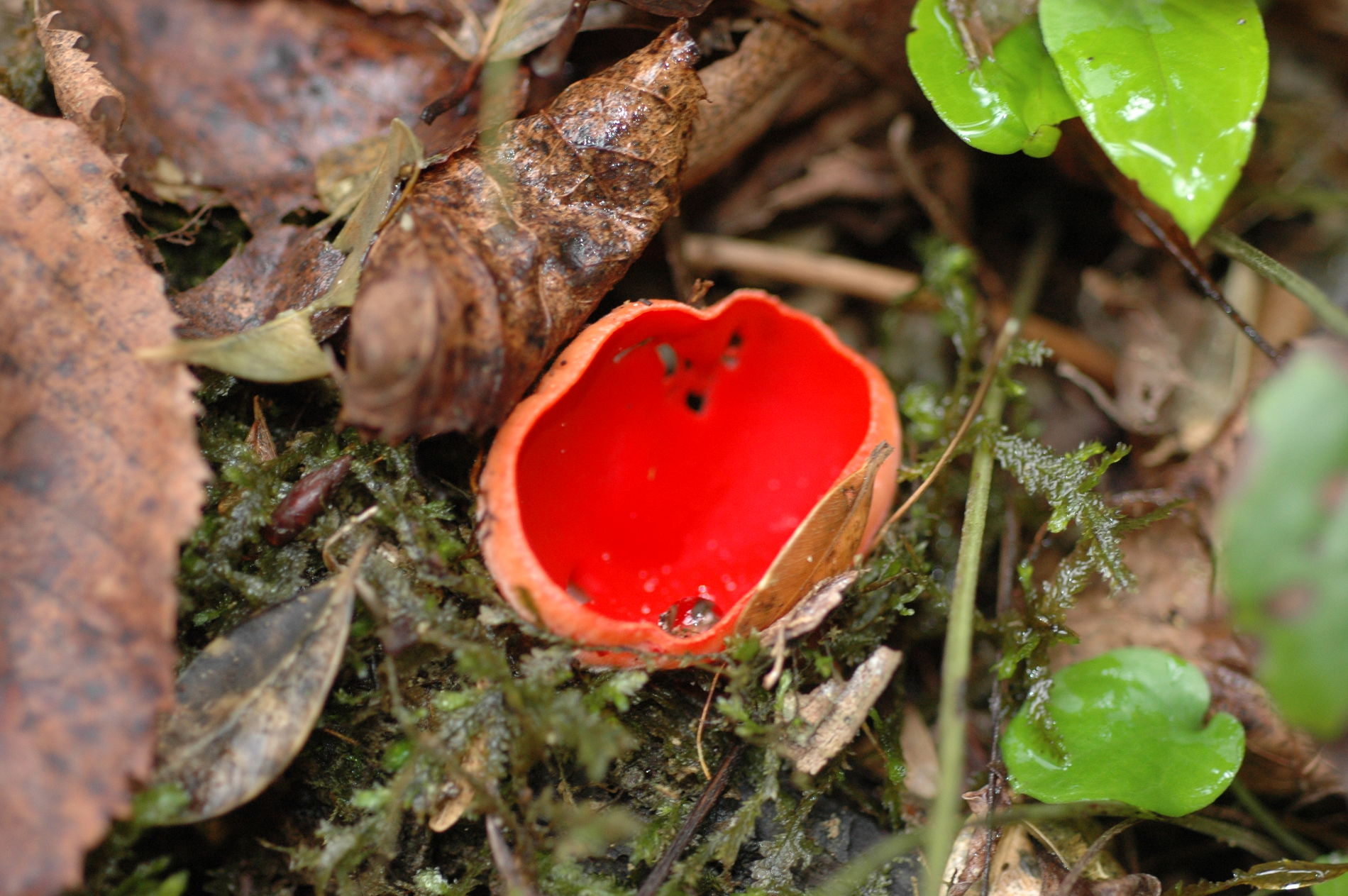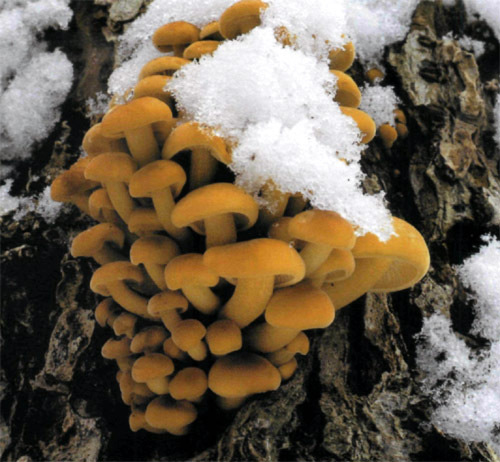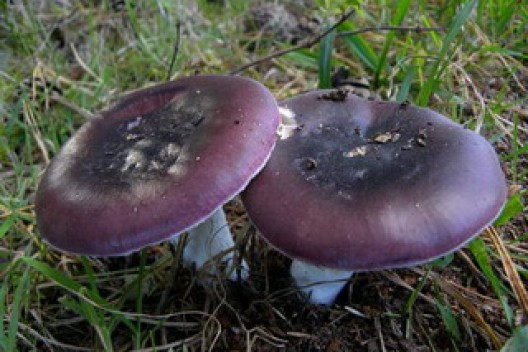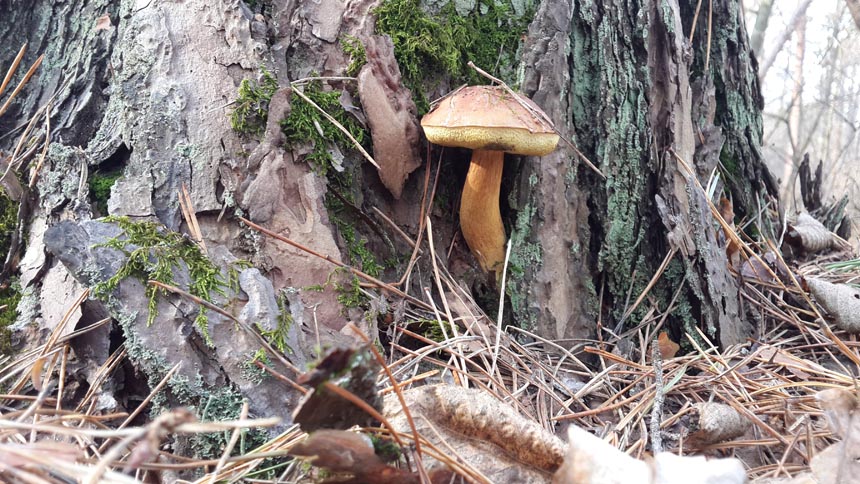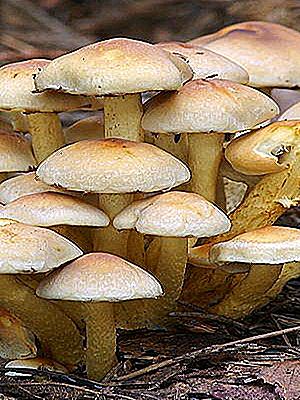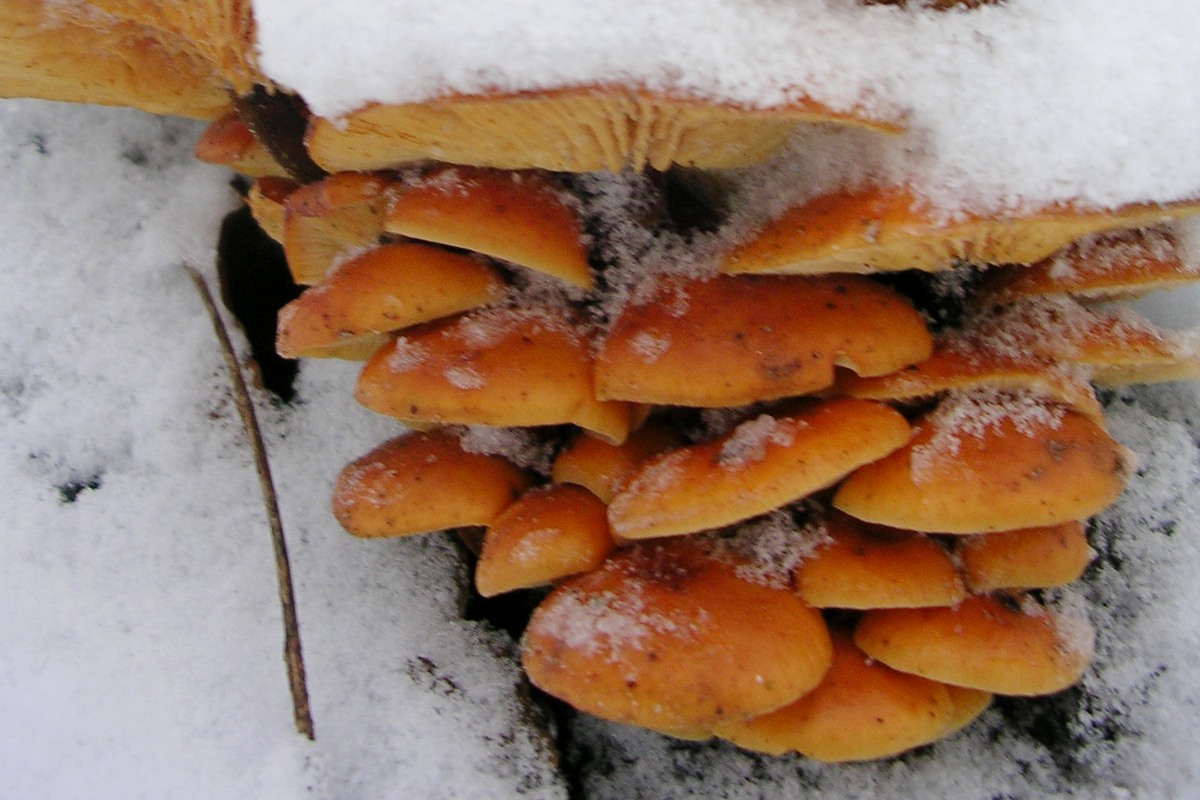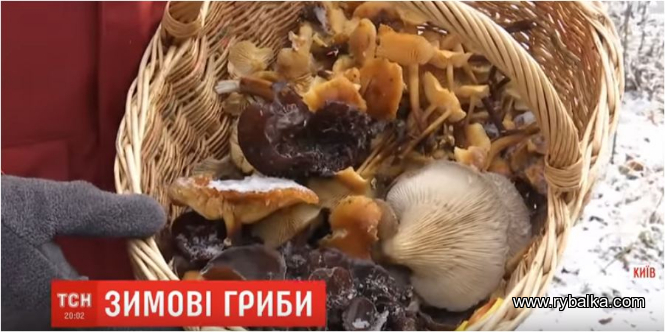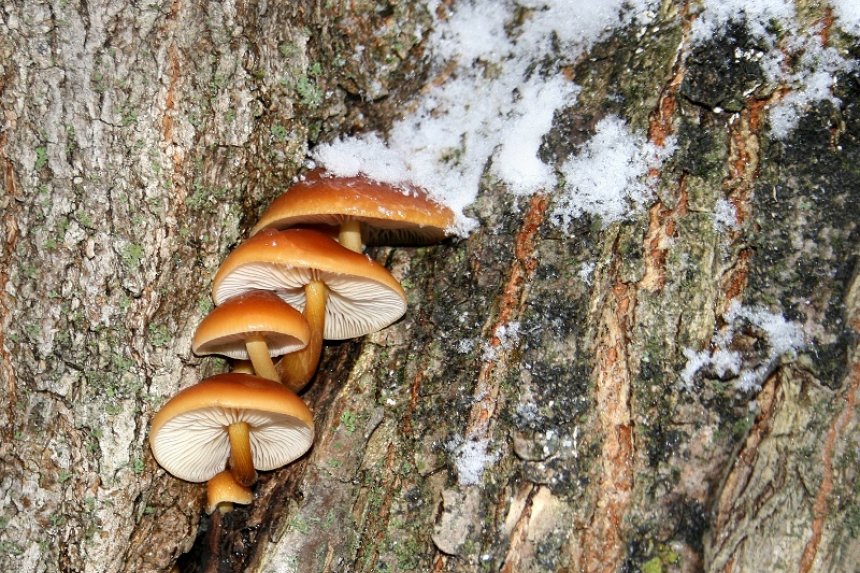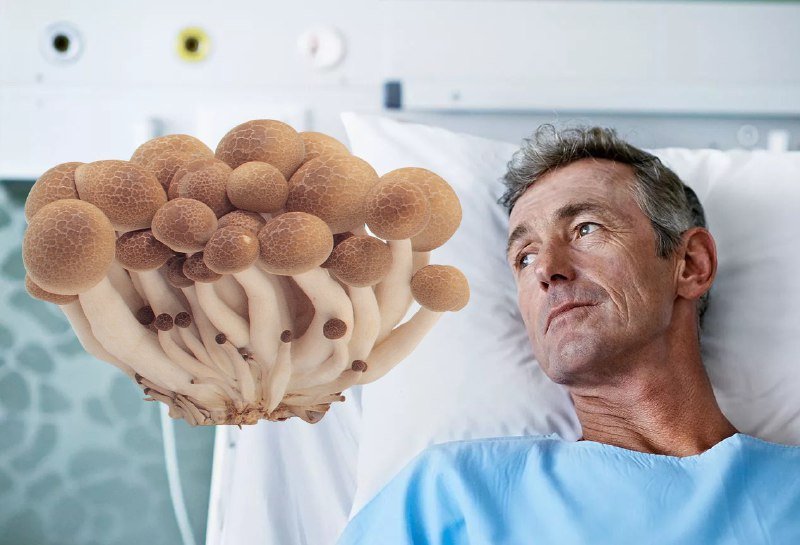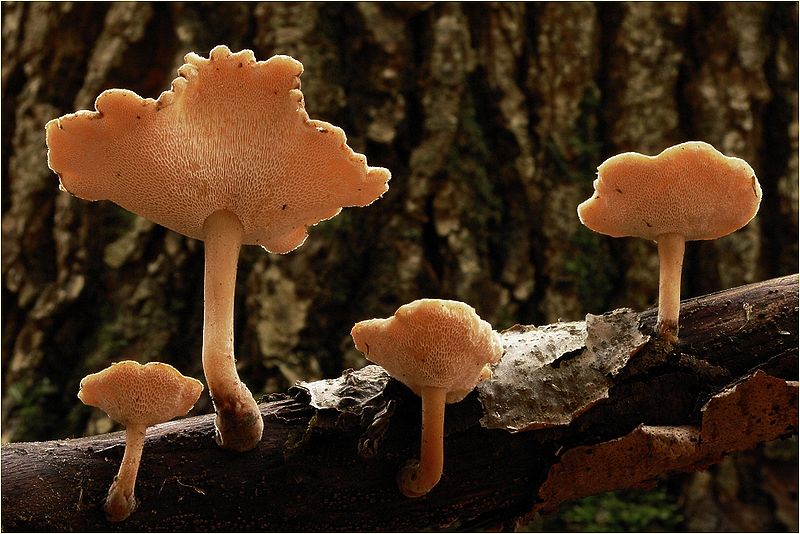Growing winter honeydew in the garden
The winter mushroom is a saprotroph, therefore, it must be grown on wood. The classic method is to make cuts in the trunks of deciduous trees and place mycelium in the holes. Ash, poplar, linden, birch, etc. are perfect for these purposes.
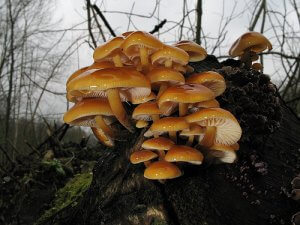
For winter mushrooms, it is recommended to take small cuts of logs with a diameter of up to 50 cm and a length of 30 to 50 cm. As a rule, there are no problems with the search for planting material. Today it is easy to find mycelium sprouted in millet grains on sale. Typically, one standard package is sufficient to inoculate 5 to 8 of these logs.
If for some reason you do not have the opportunity to purchase ready-made mycelium of winter mushroom, you can turn to the technique that was practiced before the advent of industrial technologies for growing myceliums. You just need to take a ripe winter mushroom hat and rub it over the entire surface of the log saw cut. It is better, of course, to take already dead wood, but freshly sawn wood will do. It is not for nothing that in the literature it is often noted that the winter fungus parasitizes on living, but diseased wood.
Some mushroom growers even advise extreme caution when growing winter mushrooms in the garden, so as not to inadvertently infect fruit trees with them. However, there were no cases of infection of healthy trees.
Before inoculation, the logs must be thoroughly soaked so that the moisture content of the wood is at least 50-70%. The optimal time for planting winter mushrooms is the second half of spring, or September. Infected logs are placed in small piles and left to germinate for 3-4 months. The optimal temperature regime for the development of mycelium is about 20 degrees Celsius. When the mycelium becomes visible at the cuts, the piles need to be disassembled and the logs must be dug vertically into the ground in a shaded area of the garden.
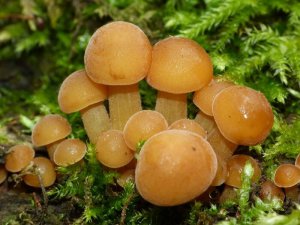
If the inoculation was carried out in the spring and using softwood, the first mushrooms can be harvested in the coming autumn. With an autumn planting, the first offspring can be expected no earlier than late winter - early spring. Winter mushrooms grow more actively when the air temperature is 8-12 degrees. At the same time, possible frosts are not at all terrible for the mycelium and fruit chalk. Mushrooms can freeze to a completely solid state, and then thaw and continue to grow. Freezing will not affect the taste of mushrooms either. The main problem here is not to miss the wave of the harvest, which can be hidden under the layer of snow.
In softwood logs, mycelium will bear fruit for 3-4 years, on hardwood - up to 7 years. If you use stumps, then the fruiting period can increase up to 10 years. The total yield of mushrooms is about 10-15% of the original mass of a log or stump.
Signs
Edible mushrooms are called mushrooms that do not require special processing, they can be cooked and eaten right away. Edible mushrooms do not contain any poisonous substances that can harm the body, they are absolutely safe for humans.
The nutritional value of edible mushrooms is divided into four categories, from high quality to low quality mushrooms.
In order to distinguish edible from inedible mushrooms, you need to know some common distinguishing features:
- edible mushrooms do not have a specific pungent odor;
- the color of edible mushrooms is less bright and catchy;
- edible mushrooms usually do not change color after cutting or breaking the cap;
- the pulp may darken during cooking or breaking;
- in edible mushrooms, the plates are attached to the stem more firmly than in inedible ones.
The video clearly shows how to distinguish edible from poisonous mushrooms using the example of the most common mushrooms. It also tells you what to do in case of poisoning:
Primary processing and preparation
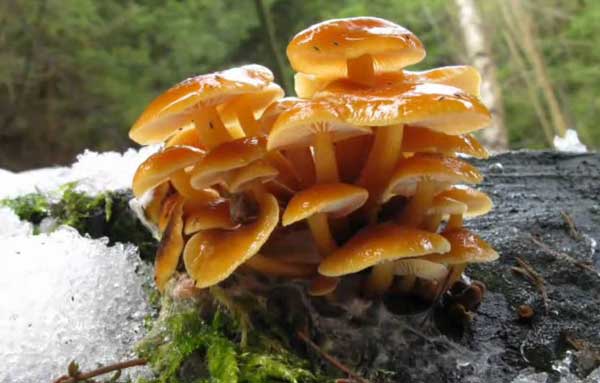
Like other mushrooms, winter must be boiled before cooking, 20-30 minutes. They are stewed, fried, andmake soups from them... At the end of frying, you can add bread crumbs to make the mushrooms crispy. For long-term storage (after which the mushrooms will still need to be cooked), after boiling and drying, you can put the caps in bags in the freezer (at a temperature of -19 ° C).
Winter mushrooms are salted, pickled and dried. True, only in a hot way. After the hats have been boiled twice, they are put in a jar, pouring also some of the water in which they were boiled. Add salt and spices and close the jar. Honey mushrooms will be salted in 2-3 weeks. You can also salt them in a dry way, drying them after cooking and without adding water to the jar.
Family of bolts
The types of edible mushrooms, photos and names from this family are familiar to many.
 Oiler
Oiler
(gray, grainy, marsh and others), but the most delicious is a real or autumn butterdish. The cap of the mushroom is covered with a slippery, brown, shiny film, which must be removed before cooking. The cap of a young mushroom itself is slightly spherical, and spread out with age. A tubular layer from light yellow to olive, covered with a white veil. The flesh is from white to yellow-creamy. Bears fruitfully, especially in rainy summers and autumn in pine plantations, on sandy soils.
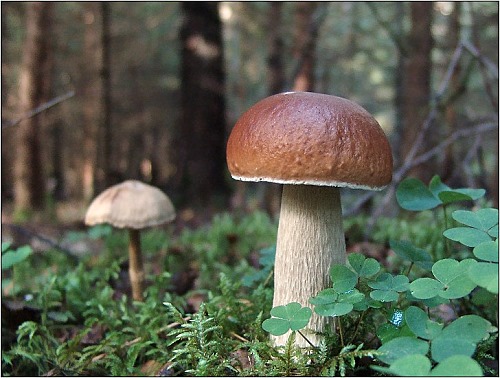 White (boletus)
White (boletus)
Depending on the place of growth, its forms may differ in the cap, the shape of the leg, the mesh of the pattern. This mushroom can be found both in summer and in autumn, both in a pine forest and in an oak forest, and its hat will depend on this. But it grows in groups, where one is there and the other is not a background. But it is "white" because under any circumstances the color of its pulp does not change, it remains snow-white.
The mushroom's hat is spherical, and as it grows old, it becomes flat. But the lower part, the pipes turn slightly yellow as they age. The leg of the mushroom is covered with a net, from light brown to burgundy.
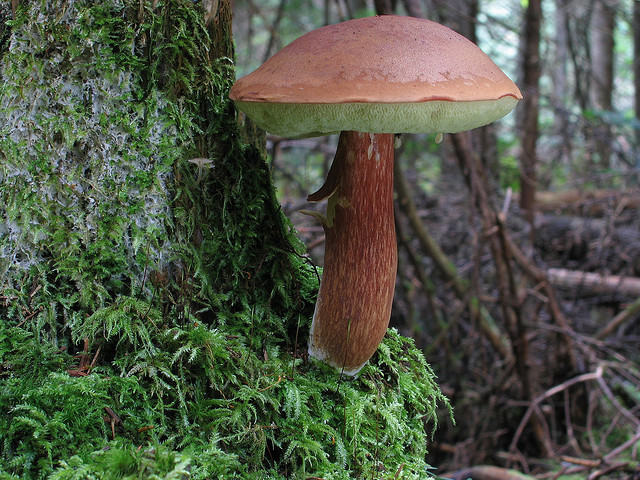 Polish
Polish
Delicious, beautiful and very aromatic. Its qualities are not inferior to white. The mushroom is not picky about the neighborhood, it grows both under a pine and under an oak, both in summer and in autumn. The hat resembles a convex brown slimy pillow and dries out in dry weather.
Polish can be easily distinguished from all the others by its bluish color entering the place where the tubular section was injured. The tubules themselves are light yellow at the beginning, and then acquire a more intense green color. When cut, the pulp also turns blue, and then becomes brownish.
The stem of the mushroom is dense, strong, white in a young mushroom, and slightly yellowed in an old one. The smell of this mushroom does not differ from a real porcini mushroom.
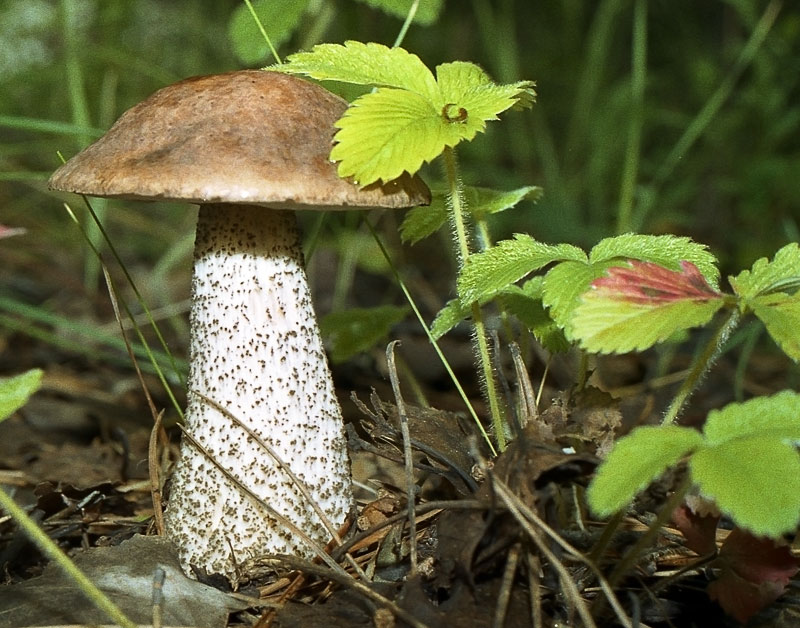 Birch
Birch
White, pinkish, marsh, gray, and many of its other brethren grow on moist soils, both under pines and under birches, both singly and crowded. Depending on the neighborhood with the tree, the mushroom hat can be dark brown, brown, light yellow. When it is wet the hat is wet, in dry weather it is dry. Sometimes the mushroom grows, and the hat seems to lag behind, then the pulp with the tubes is exposed and turns out a little.
When cut, the mushroom is light, and when weathered it turns pink, then darkens. The tubules are serrated at the ends, gray-brown. The leg is scaly, light up to 5 cm in height. A young fungus has a leg thickened from the bottom; with age, it becomes more slender.
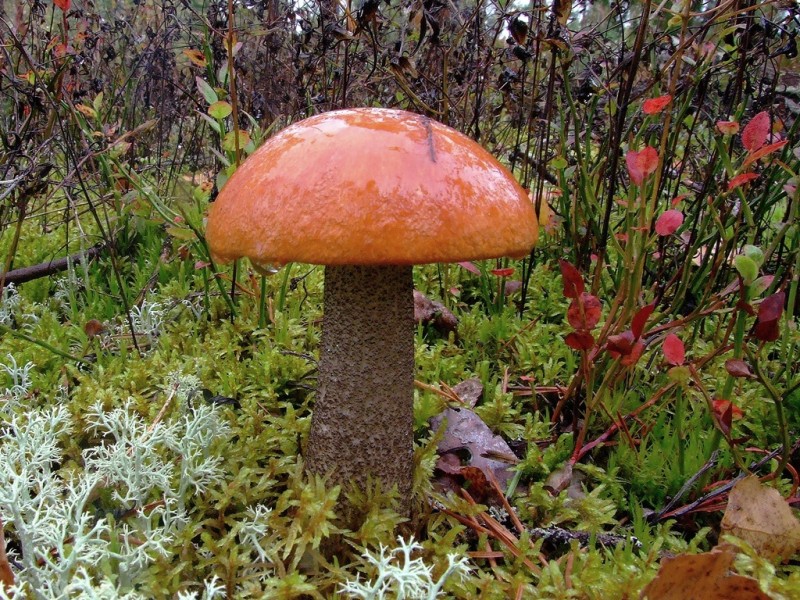 Boletus
Boletus
The name is completely unrelated to aspens, the mushroom can grow under different trees in mixed forests.
The cap of this mushroom can be either brown or red, yellow-brown and just brown. The young mushroom has a bright, juicy, rich color and convex shape, large. With age, it becomes smaller, as if drying out, and becomes much paler. The pulp is white, but turns pink when cut. The stem is long, dense, white with gray-brown scales.
The tubules of the fungus are small, gray at a young age, and then gray-brown.
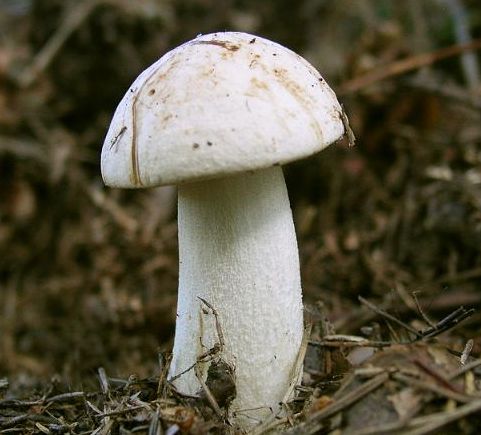 Boletus white
Boletus white
Significantly different from their fellows. Very large, with a fleshy top, white or with a slight pinkish-grayish tinge. Bottom with small pores in youth is white, then slightly grayish.
The leg is slender from top to bottom with expansion, the flesh of the base of the leg is blue, reaching black.
The white boletus is usually more autumnal than the rest.
Inedible mushrooms, if not even poisonous, are also no less than 150 species. Some inedible mushrooms are not poisonous at all, but their smell and taste are so disgusting that they cannot be eaten.
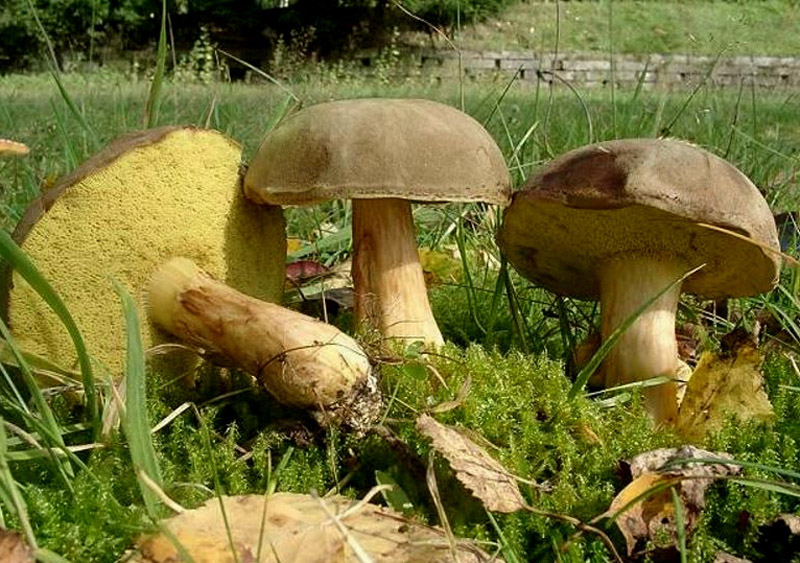 Mosswheel green
Mosswheel green
It can be either brown or red, olive green and burgundy. With a small convex, matte and dry cap. Tubular sublayer with large pores of yellow color, turns blue under mechanical action.
The leg is dark gray with a green tint, in the upper part with small scales.
The mushroom is summer-autumn, sometimes until the frost. It grows in both mixed and purely coniferous forests.
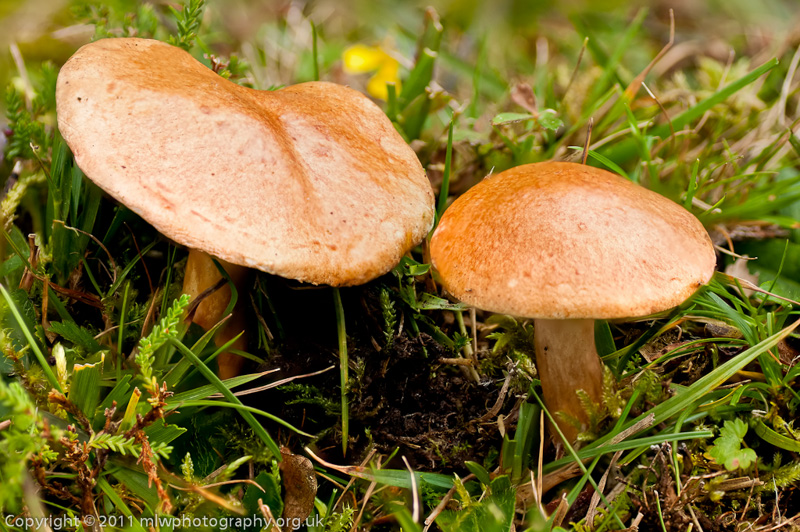 Goat
Goat
The cap is brown with dark and light shades, slimy in rain and matte, velvety in dry weather.
The pulp is firm, yellow. Tubules with a yellow and greenish tint. The leg is smooth and straight.
Loves wet places in a coniferous forest.
(traditional mushrooms)
✎ What mushrooms are autumn?
Autumn mushrooms are
edible:
- boletus and porcini mushrooms,
- aspen and brown boletus,
- gyropores and flywheels,
- butterdishes and goats,
- hedgehogs and chanterelles,
- mushrooms and scales,
- mushrooms and podgruzdki,
- ryadovki and russula,
- champignons and umbrellas,
- moss and hygrophors,
conditionally edible:
- oak and underduboviks,
- porphyry and goats,
- milk mushrooms, volushki and milkmen,
- ryadovki and talkers,
- hedgehogs and saw-leaves,
- cobwebs and cystoderm,
- moss and hygrophors,
inedible
:
- scales (light ocher, lumpy, alder, poplar),
- blades (curly, elastic, pitted, black),
- lines (autumn),
- saw-leaves and entolomas,
- false raincoats and tinder fungi,
poisonous:
- toadstools and fly agarics,
- fiber and gallerina,
- ryadovki and talkers,
- lepiots and silverfish,
- cobwebs and false champignons,
- pigs and false foams,
- entolomas and gebelomas.
Based on the ability of mushrooms to grow at different times of the year (and few people know about this), all mushrooms, both edible and conditionally edible, as well as inedible and poisonous, are divided into 4 seasons, according to which they are positioned.
And autumn mushrooms, first of all, are those whose growth period coincides with the period of the autumn season, which begins in the second half of August and lasts until the end of September, and sometimes - until the middle or even until the end of October. And autumn mushrooms include the most common and well-known mushrooms. During this period of the year (in the autumn season), the most popular species of mushrooms for harvesting grow.
✎ Concept of seasons or seasons
It is well known that the development of any living organisms in nature - people, animals, birds, fish, insects, plants and fungi is directly related to changes in their environment. Such changes are cyclical and are called seasons or - seasons. It is the change of seasons that determines the rebirth or flourishing, growth and development, formation and reproduction, the transition to a state of hibernation, as well as the death of the absolute majority of living beings on our planet. All stages of evolution and their duration are due, in a way, to the adaptation of various types of living organisms to the changing seasons.
✎ Seasonal adaptability of mushrooms
The adaptations of different individuals of wildlife are very diverse and endless, so it is easy to assume that if there are animals, fish and plants that lead an active lifestyle throughout the year (including during the cold period: late autumn, winter or early spring), then surely there must be some types of fungi that are able to successfully tolerate the same unfavorable conditions.
In addition, mushrooms, unlike plants, do not have chlorophyll, so they cannot independently assimilate carbon dioxide from the air and, like animals consisting of protein formations, are forced to eat ready-made organic compounds and also digest food. And they reproduce mainly with the help of spores, which is why extreme climatic conditions for some of their species are by no means an obstacle to successful growth and development.
Application in medicine
Winter honey agaric is unique in its useful properties. These mushrooms have more protein and amino acids than many berries, vegetables and fruits. Flammulina contains trace elements such as zinc, phosphorus, potassium, manganese, iodine, copper and many others. In this regard, only beef and milk can compete with winter honey.
Scientists and doctors have carried out deep biochemical studies that have shown the high content of various antioxidants in these mushrooms. Experiments with the discovered substances have revealed their ability to fight various malignant and benign neoplasms. In Japan, a special map has even been drawn up on which you can see the dependence of the occurrence of cancer on the level of enokitake consumption. The more often mushrooms appear in a person's diet, the lower the risk of developing a tumor.
Winter honeydew is characterized by antibacterial and antiviral properties. Thanks to this, mushrooms significantly increase human immunity. The use of Flammulina has a revitalizing and supportive effect on the liver and stomach. The content of substances that lower the level of cholesterol in the blood makes it possible to use the winter mushroom in the manufacture of medicines for the prevention and control of atherosclerosis.
This mushroom is widely used for cosmetic purposes. On its basis, special masks, lotions and creams are prepared, which eliminate dryness and flaking of the skin, and have a rejuvenating effect.
Attention! Winter honey agaric is one of the few mushrooms that are resistant to strong atmospheric pollution. They can grow in the center of a large city, on the sides of gas-polluted highways
But this in no way means that they can be collected in such places. These mushrooms accumulate a huge amount of harmful and even poisonous substances from the surrounding air. The use of such mushrooms threatens with serious poisoning.
Winter honey agaric resembles a poisonous mushroom - bordered gallery. Since these species bear fruit at different times, the likelihood of confusion is rather small. But nevertheless, it will not be superfluous to remember the main difference between these mushrooms: the gallery has a ring on the leg, characteristic of poisonous mushrooms.

Conditionally edible mushrooms
Conditionally edible mushrooms include mushrooms with a rather pungent or bitter taste, which are quite suitable for food after appropriate pre-processing (soaking or boiling). The same mushrooms include those that should be used only when young.
False chanterelle (kokoshka or orange talker)
Despite the name "false", the mushroom is quite edible, although its taste is different from the usual chanterelle.
It has a beige-orange cap that fades over time and becomes pale yellow (but with a bright yellow center and white edges). The cap plates are bright orange, frequent and large. The leg is brighter in color than the cap. The pulp in the leg is tough.
Only the caps of young mushrooms are used for food. The legs are not used at all, as they are very hard and tasteless.
Volnushka
There are several types of waves:
- White - found where birches grow. The edge of the cap is, as it were, "fluffed", of a light color. A bitter milky juice is released on the cut of the mushroom. It is used only after preliminary boiling.
- Pink - grows in a moist deciduous zone, with a predominance of birches. Whole glades of waves are often found. Fruiting time: August-October.The hat is pinkish, yellow-pink, with red splashes. Flat at an early age, as it grows, it becomes funnel-shaped. Like the white wave, the edges are "furry". The leg is hollow inside, pink.
- Swamp - grows in damp places and near swamps. The hat is flat with a wavy edge and a smooth surface, sticky. The color of the cap is grayish, lilac, light brown, lilac with a brown tint. In the middle of the cap, the color is darker than at the edges. The flesh of the mushroom is fragile, the taste is sharp-burning. Gives off pungent milky juice.
Volnushka white
Pink hair
Marsh wolf
Edible russula
There are about thirty varieties of russula. The peculiarity of these mushrooms is that they grow even in mushroom lean years, when there are no other mushrooms.
All russula are similar to each other. All have a dry cap that varies in color (from pink to black). The cap is slightly convex at first, but becomes flat over time. There is a recess in the center of the cap. All russula have a specific burning taste, which disappears after boiling. The leg of the mushroom is round, hollow, white.
The most common types of russula:
- Golden - grows on the outskirts of moss bogs. Has a bright yellow hat.
- Blue (bruise) - has shades of a hat from blue to blue-purple, blue-green.
- Green russula - has a bluish-greenish cap with brown spots.
Russula golden
Russula blue
Green russula
Morel
A mushroom with an unusual hat. Very light in weight, as it is hollow inside. A hat in the form of an elongated wrinkled cap. The color of the cap is from yellowish brown to dark gray. The leg is cylindrical in shape, almost fused with the cap. The color of the leg of young mushrooms is white, in older specimens it is yellowish.
Only young specimens are used for food. Old and overgrown morels tend to accumulate harmful and toxic substances, which is unsafe for health.
What mushrooms can be picked in winter?
During the winter, you can pick mushrooms of the following types:
- Oyster mushroom.
- False foam seroplate.
- Winter mushroom.
- Birch chaga.
- Scaly tinder fungus.
- Tinder fungus is sulfur-yellow.
- Rowing (several types).
- Autumn honey agaric.

Scaly polypore
Not all of these mushrooms are edible, but they are of certain interest, which will be discussed below. There are other nuances as well. For example, such typical autumn mushrooms as scaly and sulfur-yellow tinder fungus, autumn honey fungus and ryadovki are found only in early frosts. In addition, they can only be harvested until the thaw has come, since during the first thawing and subsequent freezing, they rapidly lose their properties.
As for true winter mushrooms, they are not only not afraid of fluctuations in winter temperature, but also use winter thawing as an opportunity for growth.

Autumn honey agaric Armillaria mellea
From "Domovodstvo" 1956
In the end, I would like to cite excerpts from the book Housekeeping ", published in 1956. “With hot salting, for 1 kilogram of mushrooms, take 2 tablespoons of salt, 1 bay leaf, 3 pieces of peppercorns and cloves, 5 grams of dill, 2 blackcurrant leaves. Pour half a glass of water (for 1 kilogram of mushrooms) into a saucepan, put salt and put on fire. When the water boils, put the mushrooms. During cooking, the mushrooms are gently stirred with a jelly so that they do not burn. When the water boils, carefully remove the foam with a slotted spoon, then put pepper, bay leaf, and other seasonings and cook with gentle stirring. … The cooked mushrooms must be carefully transferred to a wide bowl so that they cool quickly. The cooled mushrooms should be transferred with the brine into barrels or jars and closed. The pickle should be no more than one fifth by the weight of the mushrooms. Mushrooms are ready to eat in 40 to 45 days. "
Marinade for mushrooms is advised to cook like this: "For 1 kilogram of mushrooms, you need to take one and a half tablespoons of salt, half a glass of vinegar, 1 bay leaf, 0.1 grams of pepper, cloves and cinnamon and 2-3 grams of dill"
Particular attention is paid to vinegar: “The quality of marinades largely depends on the type of vinegar. Especially tasty are marinades prepared with grape or table vinegar ... with aromatic herbs
If the vinegar is strong (6 percent), then it must be diluted half with water, then add salt, sugar, spices (pepper, cinnamon, cloves, nutmeg, coriander, bay leaf, etc.), let it boil, and then cool. " ...
And one more useful tip: “To protect against mold, the marinade is poured with a thin layer of vegetable oil. Banks are closed with parchment paper and tied with twine. Store marinades in a cool dry place. "
Birch chaga is the most valuable winter mushroom
It is this winter representative of the mushroom tribe that is of the greatest value.
The appearance of this mushroom is so peculiar that it is simply impossible to confuse it with another. Birch chaga grows, as it should be, on old birches - in breaks in the bark.
It looks like a large black growth. The size and weight of birch chaga can be up to several kilograms. The main advantage of this mushroom is its pronounced antimicrobial and antiseptic properties. Medicines made from chaga have a positive effect on the functioning of the immune system, increase the body's defenses, improve metabolism and have a stimulating effect on the nervous system. Therefore, this mushroom is widely used not only in folk, but also in traditional (official) medicine.

Birch chaga
If you intend to harvest birch chaga in winter, stock up on a large and sturdy knife in advance, as a regular pocket knife will not be enough. Sometimes you even have to resort to using a tourist hatchet.
In general, when it comes to collecting winter mushrooms growing on trees, it will not be superfluous to take with you not only a large knife or hatchet, but also a stick with a pointed end like a spear, since some mushrooms grow at a decent height.
The names of edible forest mushrooms with photos and descriptions
What other names for edible mushrooms are familiar even to inexperienced mushroom pickers?
Common chanterelle
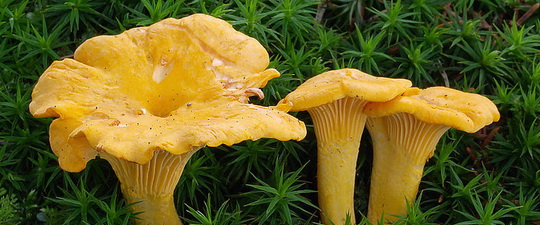
Common chanterelle (Cantarellus cibarius), real chanterelle. It is a very common and high-yielding type of mushroom. They account for approximately 20% of the harvest of all mushrooms growing in the mixed forest. There are two times more of them than Valuev.
This mushroom is found throughout the forest zone of the former USSR, mainly in the central and western regions. It grows in coniferous and mixed forests in large groups, especially in rainy summers, from July to late autumn.
The hat is up to 10 cm in diameter, fleshy, at first convex or flat, with a curled edge, then funnel-shaped, with a strongly wavy edge, smooth, egg-yellow in color. The pulp is dense, dry, rubbery, firm, yellowish-whitish, with a strong odor, reminiscent of dried fruit, and a spicy peppery taste. The mushroom almost never turns black. Plates descending on the stem, rare, thick, fold-like, yellow. The spore powder is pale yellow. Leg length up to 6, up to 2 cm thick, yellow, even, solid, smooth, naked, expanding upward, passing into the cap.
Edible tasty mushroom of the third category. It is consumed fried, boiled, dried, pickled and salted.
In the marinade and salting, the color remains, slightly turns brown. Chanterelle sauces and seasonings are especially tasty. It is rich in trace elements, especially zinc, contains substances that have a detrimental effect on the causative agents of purulent diseases.
Summer honey mushroom

Summer honey agaric (Kuehneromyces mutabilis) grows on decaying deciduous wood, stumps, especially birch, usually in large groups, from June to October.
The cap is up to 7 cm in diameter, thin-fleshy, flat-convex, with a smoothed tubercle, in a young mushroom it is covered with a cobweb private veil, wet, sticky, reddish-brown, when dry, buffy-yellow, two-color - lighter in the middle, brighter, with dark edges, as if soaked in water. The pulp is soft, watery, thin, light brownish, with a pleasant taste and smell of fresh wood.
The plates are adherent with a tooth or weakly descending, frequent, narrow, whitish, later rusty-brown. The spore powder is brown.
The leg is up to 8 cm long, cylindrical, tapering downward, often curved, at first solid, later hollow, rigid, woody, with a narrow membranous, brown, with a banded ring surface, above it is whitish-cream, below it is black-brown, more scaly ...
Edible mushroom of the fourth category, appreciated for its high taste. Used fresh, pickled, salted, dried.
Polish mushroom
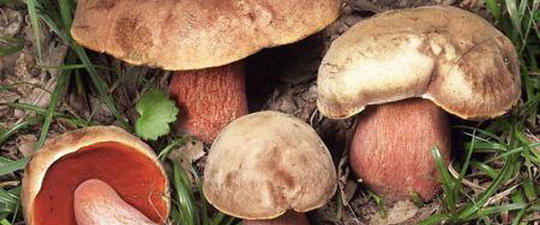
The Polish mushroom (Xerocomus badius) grows mainly in the western regions of the former USSR - in Belarus, Western Ukraine, the Baltic states, in coniferous (especially pine) and mixed with pine forests, singly and in groups, in August-September.
The cap is more or less slimy, shiny in dry weather, 5-12 cm in diameter, cushion-convex, then flat, smooth, brownish-brown, chestnut.
The pulp is straw-yellow, turns blue at the break, with a pleasant smell and taste. The tubules are adherent, sometimes loose, with small angular pores, yellowish-greenish, darkening when pressed. The leg is up to 9 cm long, up to 3 cm thick, dense, even, sometimes narrowed to the base, yellowish-brownish.
Good edible mushroom of the second category. It tastes like a porcini mushroom. It is dried, fried, salted and pickled.
Here you can see photos of the species of edible mushrooms, the names of which are listed above:
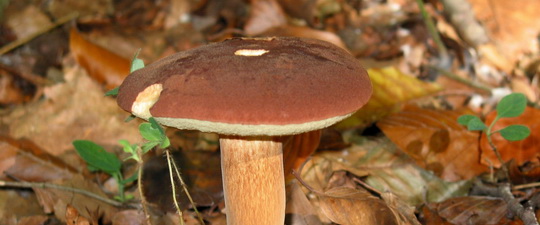
Winter mushrooms - photo and description
Winter mushroom (or flammulina) is an edible mushroom, which, in different sources, belongs to the family of rowers, then to non-nyuchkovy, then to the Fizalakriev family. The last method of classification makes it somewhat related to the autumn forest (the same family, but a different genus). Nevertheless, the winter mushroom is in any case not a relative of the summer mushroom, which belongs to the Strofariev family.
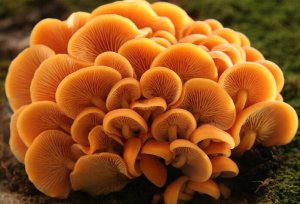
The most important feature is the fact that winter mushroom is actually a winter mushroom, and not just by name. It begins to ripen at the very end of autumn and grows abundantly at the beginning of winter. Moreover, if the winter turned out to be relatively warm with frequent thaws, then it can be harvested throughout all three winter months. The cells of the fungus, damaged by freezing, are completely restored, as soon as the air temperature rises above zero. For this reason, during the thaw, you can easily find flammulines growing from under the snow.
Although the appearance of this mushroom is quite ordinary, the late ripening time leaves no room for confusion with someone else. Even if you don't know what winter mushrooms look like, you still can't find anything else under the snow. In young winter honey agarics, the cap has a hemispherical shape, which gradually straightens with age and becomes convex-outstretched. The color of the cap ranges from tan to honey. The central part of the cap is always darker than its edges. Old mushrooms are often covered with brown spots. In wet weather (and in late autumn and winter it is almost always like this), a thin layer of mucus is kept on the surface of the winter mushroom. The diameter of the cap is average - usually up to 10 cm, in rare cases more.
The flesh of the cap is a little watery, but with a rather pleasant taste and aroma. The color of the pulp is creamy. The plates under the cap are relatively infrequent and firmly adherent, the color is also cream, although they often darken with age.
The leg of the winter mushroom has a classic cylindrical shape, however, due to the peculiarities of the mushroom's habitat (on trees and stumps), the leg is often at an angle to the cap.The top of the leg is painted in the same color as the cap, and the bottom is slightly darker. The average length of the leg is about 4-8 cm, the thickness is up to 0.8 cm. The flesh in the leg is rather tough, so it is usually not suitable for food in old mushrooms. There are no remnants of the bedspread on the leg.
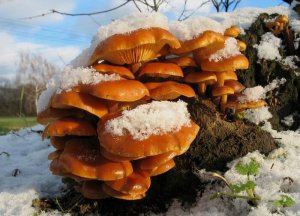
Winter honey fungus is a typical saprotroph. It parasitizes sick and damaged trees, as well as dead wood. The fungus prefers deciduous trees, especially willows and poplars. It is easiest to find it near streams, on forest edges, as well as in gardens and even parks. Winter honey agaric bears fruit in dense groups, which makes it related to classical mushrooms. The fungus is widespread in the temperate zone.
Winter mushroom can be salted and pickled
In order to avoid botulism, it is recommended to eat any canned mushrooms before the New Year. With an increase in the shelf life, the likelihood of this serious disease increases, which often ends in failure. The methods of pickling and pickling mushrooms that I use allow these mushrooms to be kept for a long time in jars or other containers without closing them with tight lids.
Salted and pickled winter mushrooms are so tasty that they are eaten instantly. They are salted and pickled only hot. They start by peeling the mushrooms, leaving only the caps. Only the uppermost part of the leg can be used. Then honey mushrooms are sorted by size. Weigh it. After that, the mushroom caps are brought to a boil and the water and foam are drained. The mushrooms are washed and boiled again for at least 35 minutes from the moment of boiling. Cooked mushrooms are laid out in an enamel pan or bucket, glass jar or other container. Salt (40-50 g of salt per kilogram of cooked fresh mushrooms), spices (garlic, allspice, cloves and dill) are added. Very little liquid is poured into the container, in which the winter mushroom was cooked. A wooden circle or a flat plate of a suitable diameter with a load is placed on top. They are needed so that even the top layer of mushrooms is in the brine. Mushrooms are salted in 2 - 3 weeks. Store them in a cool place.
This salting method has a simplified version, in which salt and spices (except garlic) are added 10 minutes before the end of cooking. Salt should be taken to taste, making the brine slightly salty. As a last resort, it will always be possible to add salt to the solution. This option is good because mushrooms can be immediately laid out in glass jars and filled with ready-made brine. No weighing, calculations of the amount of salt, etc. are needed. There is no need for a wooden circle and a load. Keep jars in the refrigerator or some other cool place. We rarely wait until the mushrooms are finally salted. We eat them a few days after salting. Add chopped onions and green onions and vegetable oil to a plate. By the way, onions placed in pickling containers can cause souring of salted mushrooms.
You can pickle boiled winter mushrooms dry, without brine. To do this, after boiling (for 40 minutes), honey mushrooms are washed with cold water and all the liquid is drained. Then put in a suitable container, sprinkling the mushrooms with salt (40 - 50 g per 1 kg of raw honey mushrooms) and spices. With this method of salting, oppression is imperative. Keep the mushrooms cool. After a week, you can eat them. It is best to wait at least three weeks for the mushrooms to be salted better.
Winter mushrooms are perfectly pickled. They are cleaned and boiled as for salting. After 25 minutes of boiling, the caps are washed with fresh water, and then put back in the pan. Pour marinade, which is prepared as follows: add 2 tbsp to 1 liter of water. tablespoons of granulated sugar, 1.5 tbsp. tablespoons of salt, 3 pcs. cloves and allspice. The proportions can be changed (to taste). Pour 4 tbsp. spoons of 9% table vinegar. After that, the mushrooms are boiled in the marinade for 10 minutes. Cooled, transferred to glass jars and loosely closed (not rolled up) with lids. Store jars in a cool place.
Description
The diameters of the caps of these mushrooms vary from 2 to 10 centimeters. The surface of the cap is smooth to the touch, slightly slimy. The color can be yellow with a brown or orange tint, with a dark center and almost transparent edges. In young honey agarics, the cap is convex with tucked edges, as the mushroom matures, it straightens. An interesting feature of flammulina is the dependence of color on the type of tree on which it grows.
The plates can grow to the stem, or they can remain free, the color ranges from white to ocher. Characteristic bridges are visible between the plates. With age, the color of the plates darkens, they become more rare and wide. Spore powder, like most mushrooms, is white. Disputes can take many forms.
The flesh of the winter mushroom is thick, dense, creamy in color, with a mild, pleasant taste and persistent mushroom aroma.
The leg is long but thin. The structure of the leg is dense, elastic, cylindrical in shape. It is painted in different shades of brown.

Mushroom composition, benefits
The composition of mushrooms contains many useful substances and vitamins, namely: vitamins A, B, C, E, D, protein, calcium, potassium, phosphorus, iron, as well as folic and niacin. 100 grams of mushrooms contain 4 g of proteins, 3 g of carbohydrates, 1 g of fat.
Mushrooms - a source of vitamins, protein, minerals
The product is characterized by a balanced content of all valuable elements. There is no cholesterol in it, the number of calories is minimal, since 90% of the mushrooms are water. If there are no contraindications, they can be eaten daily (in moderation, about 150 g).
They bring significant benefits to the body - they improve the functioning of the nervous system, heart and blood vessels, have a positive effect on blood formation, strengthen bone tissue, and reduce blood sugar levels.
Interesting fact: mushrooms contain a protein called lectin. Currently, its properties are being thoroughly studied by specialists in the field of oncology with the aim of using the protein in the diagnosis and therapy of diseases.
Benefit and harm
Winter mushrooms are high in antioxidants, including ergothioneine (a typical mushroom antioxidant that stimulates the immune system and restores skin after exposure to UV rays) and proflamine (in experiments on mice with cancer, it increased their lifespan by 85%). They also contain lectin and P-D-glucan, which have antiviral and antibacterial properties. With regular use winter mushroom treats some diseases of the liver and stomach (for example, ulcers).
The use of these honey mushrooms, according to the available data, cannot be harmful. However, they themselves - in a living state - can cause serious damage to gardening, parasitizing on fruit trees. Therefore, in order to avoid this, it is necessary to coat the places of damage to the trunks with oil paint (since they are the most susceptible to infection).
Thus, picking mushrooms in winter can diversify not only the gray sunless weekdays, but also your New Year's table. And at this table, you can, as it were, casually mention that you picked these mushrooms a couple of weeks ago - then the guests will be surprised!
Outcome
It turned out to collect so many "snow" mushrooms, which I am very glad, tk. expected to find only a few winter mushrooms:
 Mushrooms, under the snow again
Mushrooms, under the snow again
The snowfall was so strong that the basket was constantly covered with snow.
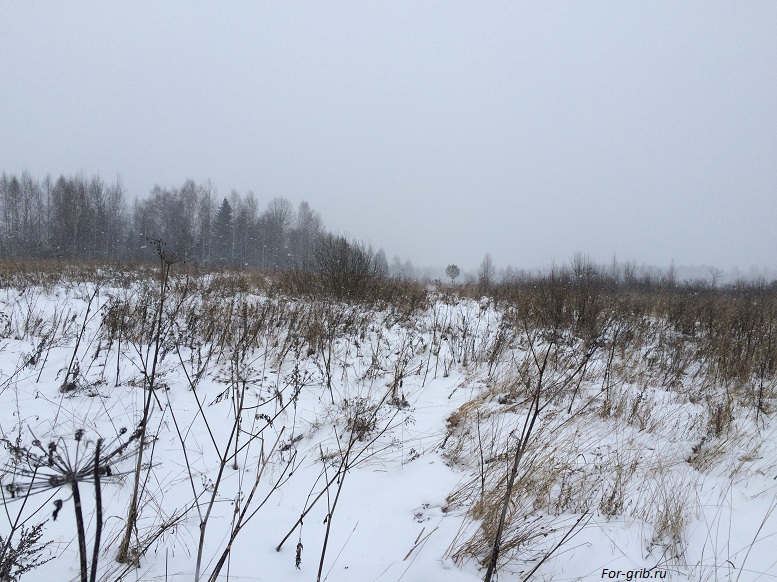 Heavy snowfall
Heavy snowfall
It was very easy to sort out the mushrooms - no worms, slugs, etc.
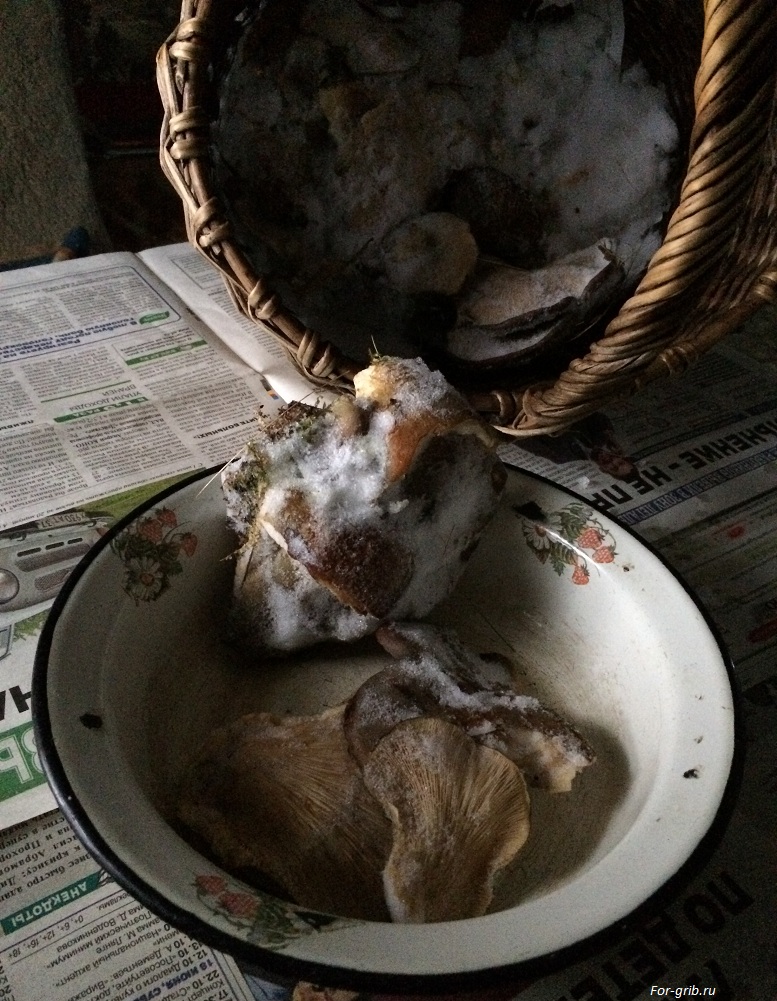 Frozen mushrooms
Frozen mushrooms
The result is this:
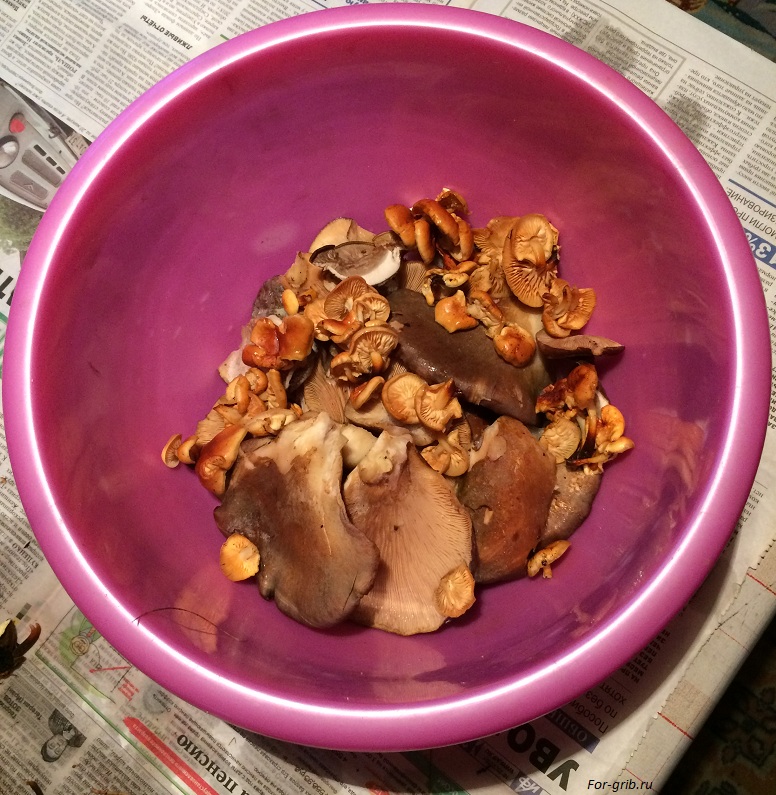 The result of collecting "snow" mushrooms
The result of collecting "snow" mushrooms
In general, there are a lot of mushrooms:
 Sorted and washed mushrooms
Sorted and washed mushrooms
I decided to fry them, cutting the oyster mushrooms into large slices, but did not cut the mushrooms at all - in order to better feel the taste of the mushrooms:
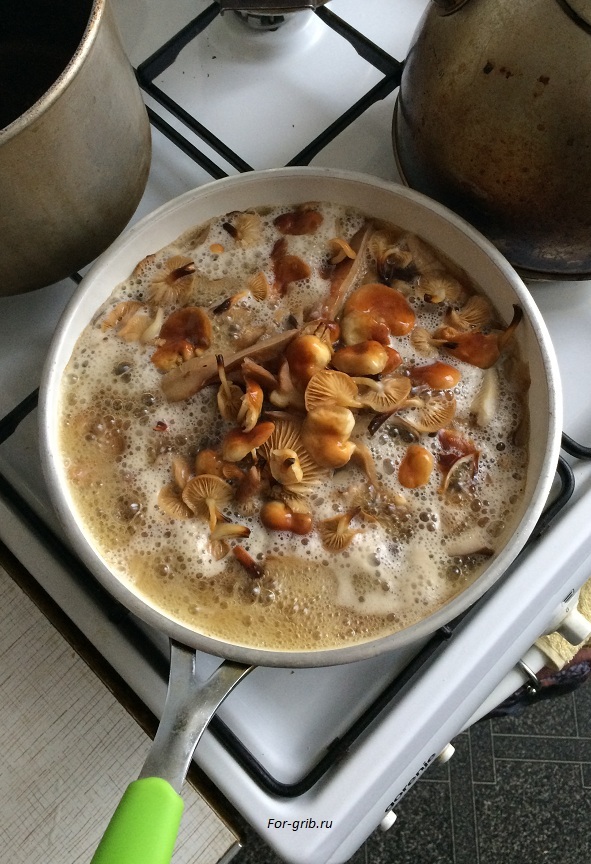 Fry winter mushrooms
Fry winter mushrooms
It turned out very tasty. The taste of oyster mushrooms was especially pleasant. Fried without oil, in water, with the addition of onions and a small amount of flour at the very end:
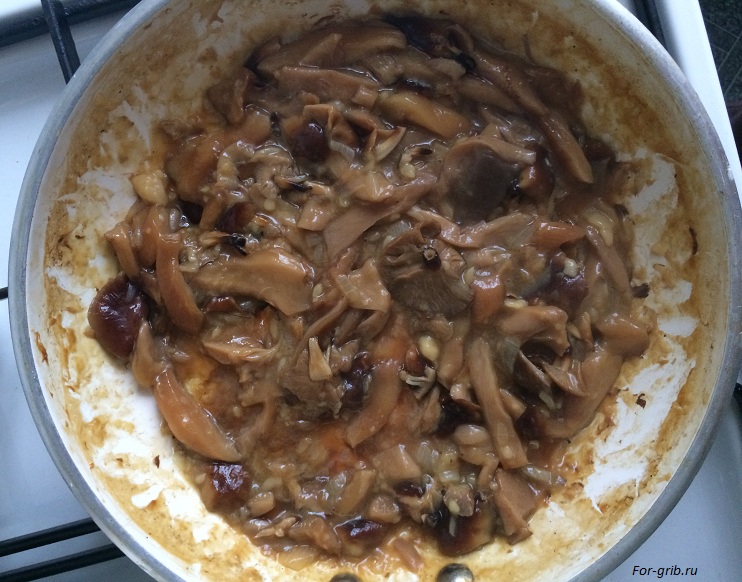 Fried oyster mushrooms and winter mushrooms
Fried oyster mushrooms and winter mushrooms
What conclusion can be drawn? There are mushrooms under the snow!
If we want to find oyster mushrooms or chanterelles, you should know where they grow (notice from summer-autumn), and winter mushrooms are already clearly visible on trees against a white background.
I think this article will dispel beliefs about the mushroom picking period and inspire you to hike in the winter forest. Good luck!

 Boletus
Boletus